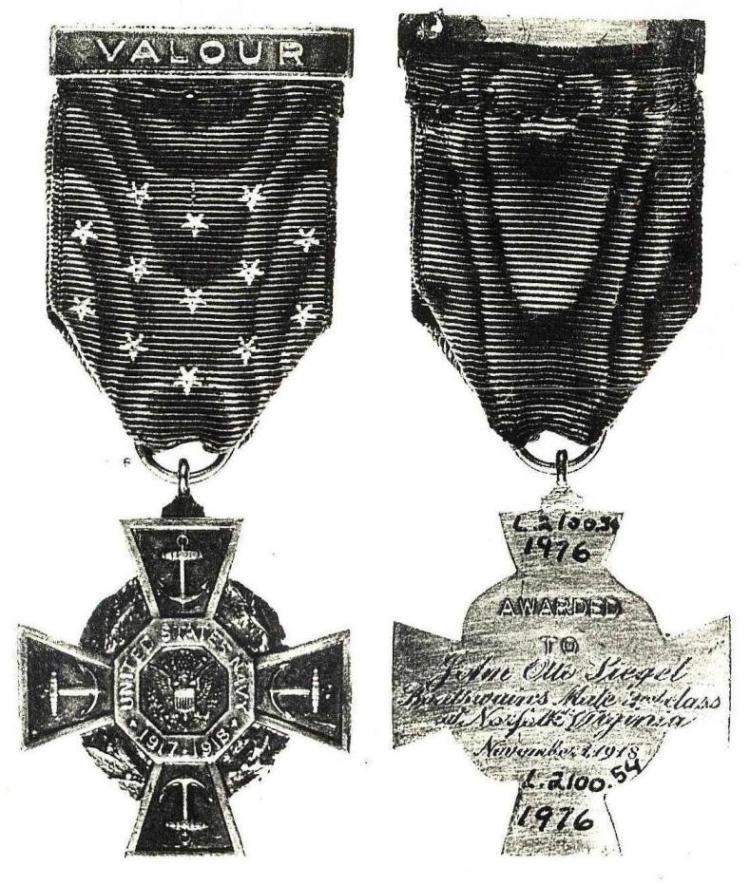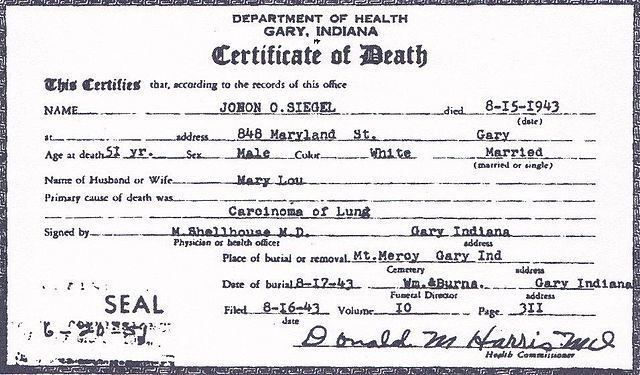Died August 15, 1943 Name John Siegel | Relations Margaret Jean Siegel Battles/wars World War I | |
 | ||
Born April 21, 1892Germany ( 1892-04-21 ) Spouse(s) Theresa NealisMary Lou Siegel | ||
Allegiance United States of America | ||
John Otto Siegel (April 21, 1892 – August 15, 1943) was a United States Navy Boatswain's Mate Second Class who earned the Medal of Honor for extraordinary heroism while serving on board of the Mohawk (YT-17) during World War I.
Contents

AWARDED
TO
John Otto Siegel
Boatswain's Mate 2nd Class
at Norfolk Virginia
November 1, 1918
Early life
John Otto Siegel was the adopted son of Julius N. Siegel and Annie Vance, both of Germany. John was brought to the US from Germany arriving in New York via Canada in October 1899 with his mother and father. They lived for a short time in Winnipeg, Canada where Julius, listed as a Roman Catholic, worked as an architect. By 1903, Julius Siegel was living in Milwaukee and still working as an architect. By 1905, John and his mother are also with Julius in Milwaukee.
First Enlistment
Siegel enlisted with the Navy on 21 May 1909 in Milwaukee, Wisconsin with his parents consent just after turning 17 years of age. Siegel spent his first 7 months of service serving aboard the USS Constellation (1854) as an "Ordinary Seaman" during the year of 1909. In 1910 Siegel transfers to the USS Hancock (AP-3) for a month then he transfers to the USS Virginia (BB-13) which was docked at Hampton Roads, Virginia in 1909 for modifications. During this time he spends 25 days in Norfolk Naval Hospital suffering from Dementia. Siegel continued to live with his aging parents at 418 12th Street Milwaukee, WI. In December 1910 he transfers to the USS Franklin (1864) where he remains until June 1911.
In 1911, Siegel is shown as an "agent" and still living with his father in Milwaukee. By the end of June he is working aboard the USS North Dakota (BB-29)where he will serve the remainder of his 1st enlistment. In 1912, Siegel now is listed as a "sailor" at the same address with his parents.
On 22 September 1912, John married his first wife Teresa Rose Neilas, age 19 years. The marriage took place at St. James Catholic Church, Newark, New Jersey. The parents of John are listed as Julius Siegel & Anna Vance and the parents of Teresa are listed as John Neilas & Margaret Buckley. John and Theresa move to 156 Green street in Newark, New Jersey.
Just two days after he is married Siegel goes on leave from set to return to the USS North Dakota on the morning of September 25, 1912. Siegel fails to return to duty and is wanted for desertion. On the 23rd of January 1915 a reward is posted for Siegel giving his last know address and physical description. On the 1st of February 1915 Siegel is captured and on the 6th his is brought into the receiving ship at New York City by Detective W. L. Beers of 60 Wall Street New York City. He is listed as being in civilian clothing and in good physical condition. For his desertion of 2 years and 4 months Seaman Siegel is sentenced by General Court-Martial to one and one half years of confinement and hard labor and to be dishonorably discharged at the conclusion of his sentence. His original sentence was reduced to one year but after serving only 8 months Siegel was released due to his excellent conduct. During his sentence Siegel began a campaign to be re-enlisted and had recommendation, including one from the Commander of the prison ship USS Southrey where he was held.
Second Enlistment
On the 15th of December 1917 Siegel was successful and re-enlisted with the Navy, his draft card states he and Teresa have one child, Margaret Jean "Virginia" Siegel. His draft card also shows that he is a wagon driver "teamster" working for Wells Fargo Company Express. For the first year of his second enlistment Siegel spends his time working in the Navy Yard at Norfolk, VA.
On 1 November 1918, Siegel is working as a Boatswain's Mate 2nd Class for the US Navy on board the tugboat Mohawk (YT-17). Working in the Norfolk Naval Shipyard the Mohawk rushes to give aid to a burning ship, the schooner Hjeltenaes, which was tied up along the Beltline Bridge. Siegel was able to rescue two men from the crew's quarters and was going back a third time when he was trapped by a burst steam pipe. Overcome by the smoke, Siegel collapsed and had to be rescued by his shipmates. Medical officers worked on him most of the night fearing he would die. For his actions Siegel was recommended and awarded the Congressional Medal of Honor for his actions along with a $100 gratuity.
After a short recovery Siegel is back at the Receiving Ship in Norfolk, VA until March 1919 when he transfers to the USS Hopewell. On June 16, 1919 Siegel is once again wanted for desertion for a period of 3 months and 6 days. He was sentenced to 6 months restriction to Ship or Station and maintain a satisfactory record to terminate at any time after 3 months at the discretion of the commanding officer. Approved on 22 October 1919 and the restrictions to terminate 27 January 1920. However on 15 March 1920 he was charged with falsehood and attempt to obtain money under false pretense and the Commanding Officer ordered the dishonorable discharge of his second enlistment. Prior to his court-martial Siegel undergoes a mental evaluation during which he state he had been worried and exceedingly nervous for several months prior to his nomination for the Medal of Honor. He had been worried over domestic affairs and depressed after recently learning that he was adopted. However he was found fit for trial.
Medal of Honor citation
Citation:
For extraordinary heroism while serving on board the Mohawk in performing a rescue mission aboard the schooner Hjeltenaes which was in flames on 1 November 1918. Going aboard the blazing vessel, Siegel rescued 2 men from the crew's quarters and went back the third time. Immediately after he had entered the crew's quarters, a steam pipe over the door bursted, making it impossible for him to escape. Siegel was overcome with smoke and fell to the deck, being finally rescued by some of the crew of the Mohawk who carried him out and rendered first aid.
Medal Inscription
AWARDED
TO
John Otto Siegel
Boatswain's Mate 2nd Class
at Norfolk Virginia
November 1, 1918
Later life
By 1920, after Siegel receives a "less than honorable" discharge from the Navy, he continues to work as a driver. Later, it is believed Siegel works as an ironworker on the Brooklyn Bridge or simply a bridge in Brooklyn, according to family.
In May 1929 Siegel writes to the Navy and request they give him a 3rd enlistment. He is unsuccessful in his plea. He is living at the Hotel Delaware in Milwaukee, Wisconsin.
Around 1930, Siegel abandons his wife and daughter and heads to Oklahoma to work in the oil fields. They never divorced and he starts a new life never having any contact with them again.
In 1935, Siegel shows up in Lavagas (believed it to be Las Vegas) per the 1940 Census records. And in 1940, Siegel is found in Baltimore, Maryland as a lineman in a shipyard living with his second wife, 20 years his younger, Mary Lou Siegel from Oklahoma.
On May 28, 1935 the New York chapter of the Red Cross writes a letter on behalf of John Otto Siegel to the Bureau of Navigation, Navy Department, Washington D.C. requesting a duplicate Medal of Honor be issued. The letter states that in November 1934 John was employed as an "Iron Worker" on the Boulder Dam project, in the "Death Valley Junction" of Nevada. And during this time a fire swept through the camp, believed to be Williamsville (known to its inhabitants as Ragtown) destroying all his belongings including his medal and service documents. On June 17, 1935 the Bureau replies with instruction on how to apply for a replacement medal.
On the 26th of November 1936 Siegel make another request that the Navy allow him to reenlist.
On the 5th and 16 April 1941 Siegel writes to the Navy requesting a replacement Medal of Honor and ribbon bar pin or at least a letter stating he was the holder of the Medal of Honor or a new station. He states it was lost in a home fire. His return address is listed as 110 Madison Street San Antonio, Texas. On 31 July 1941 his request is denied due to his dishonorable discharge and his previous replacement medal was sent contrary to existing instructions due to same. His ruling is compared to the Judge Advocate General's ruling on Medal of Honor recipient William Henry Jaeger, for actions 16 July 1900, with two less than honorable discharges he was approved for the Medal of Honor but the medal was not to be delivered.
25 April 1942 Siegel files a World War II Registration Card under the name John Robert Siegel born in New York City. In prior official documents John Otto Siegel states his birth location as Berlin, New York as well as Milwaukee, Wisconsin. John Robert is listed as 5 foot 8 inches. In prior official documents John Otto is listed as 5 foot 7 inches, 5 foot 7 1/4 inches and 5 foot 8 inches. John Robert has blue eyes, brown hair, and light complexion, and weighing 160 pounds. In prior official documents John Otto is described as having blue eyes, brown hair, and ruddy complexion and weighing 123 and later 144 . John Robert is living at Hotel London in Janesville, Wisconsin and working in Tulsa, Oklahoma with someone from Henryetta, Oklahoma listed as someone whom will always know his address. His second wife Mary Lou is from Henryetta, Oklahoma (1935) as stated on the 1940 federal census. And lastly John Robert is an iron worker. Prior documentation states John Otto was frequently an iron worker.
In 1943, at the age of 51, Siegel dies of lung cancer. The front of the document shows his middle initial as "O" where as the reverse of the docuemnt has his middle initial as an "R".
Social Security Application and Claims Index, 1936 - 2007 show Jack Atto Siegel and John Robert Siegel are the same person. The name change or modification is not explained.
Signatures from official documents of John Otto Siegel and John Robert Siegel show interesting similarities such as the "." placed after each individual name or initial. The change in the "S" is also the same between the 1941 request for a replacement Medal of Honor and the 1942 World War II Registration card. No other documents are found for anyone named John Robert Siegel or Jack Atto Siegel, that have any matching information, outside of these documents.
